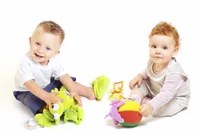It may sound cute when a pre-school child says “wuv” instead of “love”, or “go potty” when they need to use the bathroom. But if it’s your child who can’t pronounce certain sounds, isn’t talking in understandable sentences, or is very quiet it becomes a concern that may require speech, language or hearing early intervention.
According to the American Speech-Language-Hearing Association (ASHA), the development of speech and language skills is strongly linked to later thinking ability, social relationships, reading, writing and school success. Following developmental milestones established by ASHA gives parents a good idea of when to expect certain speech and language skills to develop. Typically, children follow the same sequence, (such as learning to use single words before two word combinations), but each child may develop at a different pace.

ASHA research shows that between the ages of 12 and 24 months, toddlers can typically add more words every month and can ask one- or two-word questions like “Go bye-bye?” or “What’s that?” Most children can put two words together in a simple sentence — “more cookie” or “mommy book” — by 18 months. Children around this age range use many different consonant sounds at the beginning of words. They are showing how they hear and understand by participating in the back-and-forth of a conversation. Most toddlers can point to a few body parts when asked, follow simple directions, and understand basic questions such as, “Where’s your shoe?”
Speech therapists recommend parents ask toddlers to point to pictures in a book and label items they see. They also recommend reading, singing and telling rhyming stories; the repetition and sound patterns are building a lifelong connection with your child while keeping language at an appropriate level for beginners.
Children between 24 months and 36 months usually have a word for most concepts. They can use two- or three-word “sentences” to talk about and ask for things. Their speech is understood by familiar listeners most of the time, and they often ask for objects by naming them. They can understand common opposites such as: go-stop, in-on, big-little or up-down. Children this age can also follow two-step requests, such as “Get the book and please put it on the table.”
Most children between the ages of 3 and 4 can talk about activities at school or at friends’ homes. They speak clearly enough so that people who are not family usually understand their speech. This age range can use sentences with more than four words, and they talk easily without repeating syllables or words. It’s important to note if your child can understand who, what, where and why questions, and if those questions can get a conversation started with an appropriate response.
Children have a speech or language problem when they are unable to produce speech sounds correctly or fluently, when it’s often difficult for others to understand their speech, and they are not participating in conversations. Nancy Rogers, a speech language pathologist who lives in Irvington, recommends that parents discuss concerns with their child’s pediatrician, and schedule speech, language and hearing evaluations if the child is not meeting developmental milestones and is becoming frustrated with their inability to communicate.
Rogers explains that children who are just learning to speak rely on one-word utterances to communicate a variety of intents, such as commenting, requesting or protesting. As children acquire more language, they typically use two- to three-word phrases to communicate. Word order is usually correct; but some children use the wrong tense for a verb or leave out possessive markers; they may use phrases like “daddy shoe” instead of “daddy’s shoe”.
Words commonly words mispronounced by some young kids are: wuv (love); cacker (cracker); duice (juice); nana (banana); wabbit (rabbit); baw (ball); kuck (truck); cah (car); tair (chair); geen (green); dis (this); or fum (thumb). Multisyllabic words and consonant clusters can be tricky because these sounds typically require more sophisticated motor control of the jaw, tongue and lips. Rogers adds that difficult sounds for some pre-schoolers are: the letters: l, r, s, and the “ch” sound; “j” as it sounds in jelly; and “th” as in “them” and “thumb”.
Dobbs Ferry mom Gina Sparta knew that her son, Ryan, was 18 months and barely saying anything, but she didn’t know if this was typical. Her sister, an educational therapist, suggested having Ryan evaluated by a speech professional, but her husband thought he would start talking over time. Sparta trusted her instinct and had her son evaluated through the Early Intervention Program at the Westchester County Health Department. Parents who have children under the age of 3 can call (914) 813-5094 to book a free, multidisciplinary evaluation to determine if their child is eligible for EI services. The Committee on Preschool Education (CPSE) at a child’s local school district is responsible for the pre-school special education program for eligible children after they turn 3.
Sandi Lieb-Geiger, a mom who lives in Ardsley, believes that one of the best ways to identfy a speech develoment problem is to listen to your child compared to other children the same age, and to identify if other adults and children can understand your child. “I recommend that if your child has a history of ear infections, get their hearing checked early and often,” she says. “My son’s hearing had been reduced 60 percent due to blockages from ear infections, and we didn’t realize it until his speech issues were diagnosed.”
JUMP-START GUIDE
ASHA has published Talking On The Go, which parents can use from birth to age 5 as a resource for helping their child develop communication skills through play and everyday activities at home and on-the-go. The book includes more than 300 activities to enhance speech and language development in four major areas: building vocabulary, listening and speech production, reading/writing readiness, and participation in conversations. More details about the book and information about how parents can enhance their child’s speech, language, hearing and listening are at www.asha.org.





















